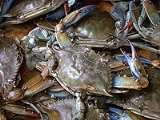
Crab
Overview
True crabs are decapod
crustacean
s of the infraorder Brachyura, which typically have a very short projecting "tail
" ( = short, = tail), or where the reduced abdomen
is entirely hidden under the thorax
. Many other animals with similar names – such as hermit crab
s, king crab
s, porcelain crab
s, horseshoe crab
s and crab lice
– are not true crabs.
Crabs are generally covered with a thick exoskeleton
, and armed with a single pair of chelae
(claws). Crabs are found in all of the world's oceans, while many crabs live in fresh water
and on land
, particularly in tropical regions.
Decapoda
The decapods or Decapoda are an order of crustaceans within the class Malacostraca, including many familiar groups, such as crayfish, crabs, lobsters, prawns and shrimp. Most decapods are scavengers. It is estimated that the order contains nearly 15,000 species in around 2,700 genera, with...
crustacean
Crustacean
Crustaceans form a very large group of arthropods, usually treated as a subphylum, which includes such familiar animals as crabs, lobsters, crayfish, shrimp, krill and barnacles. The 50,000 described species range in size from Stygotantulus stocki at , to the Japanese spider crab with a leg span...
s of the infraorder Brachyura, which typically have a very short projecting "tail
Tail
The tail is the section at the rear end of an animal's body; in general, the term refers to a distinct, flexible appendage to the torso. It is the part of the body that corresponds roughly to the sacrum and coccyx in mammals, reptiles, and birds...
" ( = short, = tail), or where the reduced abdomen
Abdomen
In vertebrates such as mammals the abdomen constitutes the part of the body between the thorax and pelvis. The region enclosed by the abdomen is termed the abdominal cavity...
is entirely hidden under the thorax
Thorax
The thorax is a division of an animal's body that lies between the head and the abdomen.-In tetrapods:...
. Many other animals with similar names – such as hermit crab
Hermit crab
Hermit crabs are decapod crustaceans of the superfamily Paguroidea. Most of the 1100 species possess an asymmetrical abdomen which is concealed in an empty gastropod shell that is carried around by the hermit crab.-Description:...
s, king crab
King crab
King crabs, also called stone crabs, are a superfamily of crab-like decapod crustaceans chiefly found in cold seas. Because of their large size and the taste of their meat, many species are widely caught and sold as food, the most common being the red king crab, Paralithodes camtschaticus.King...
s, porcelain crab
Porcelain crab
Porcelain crabs are decapod crustaceans in the widespread family Porcellanidae, which superficially resemble true crabs. They are typically less than wide, and have flattened bodies as an adaptation for living in rock crevices...
s, horseshoe crab
Horseshoe crab
The Atlantic horseshoe crab, Limulus polyphemus, is a marine chelicerate arthropod. Despite its name, it is more closely related to spiders, ticks, and scorpions than to crabs. Horseshoe crabs are most commonly found in the Gulf of Mexico and along the northern Atlantic coast of North America...
s and crab lice
Crab louse
Crab lice are parasitic insects notorious for infesting human pubic hair. The species may also live on other areas with hair, including the eyelashes. They feed exclusively on blood...
– are not true crabs.
Crabs are generally covered with a thick exoskeleton
Exoskeleton
An exoskeleton is the external skeleton that supports and protects an animal's body, in contrast to the internal skeleton of, for example, a human. In popular usage, some of the larger kinds of exoskeletons are known as "shells". Examples of exoskeleton animals include insects such as grasshoppers...
, and armed with a single pair of chelae
Chela (organ)
A chela is a pincer-like organ terminating certain limbs of some arthropods. The name comes from Greek through New Latin . The plural form is chelae. Legs bearing a chela are called chelipeds. Another name is claw because most chelae are curved and have a sharp point like a claw....
(claws). Crabs are found in all of the world's oceans, while many crabs live in fresh water
Freshwater
Fresh water is naturally occurring water on the Earth's surface in ice sheets, ice caps, glaciers, bogs, ponds, lakes, rivers and streams, and underground as groundwater in aquifers and underground streams. Fresh water is generally characterized by having low concentrations of dissolved salts and...
and on land
Land crab
Gecarcinidae is a family of true crabs that are adapted for terrestrial existence, commonly known as land crabs. Similar to all other crabs, land crabs possess a series of gills. In addition, the part of the carapace covering the gills is inflated and equipped with blood vessels. These organs...
, particularly in tropical regions.

